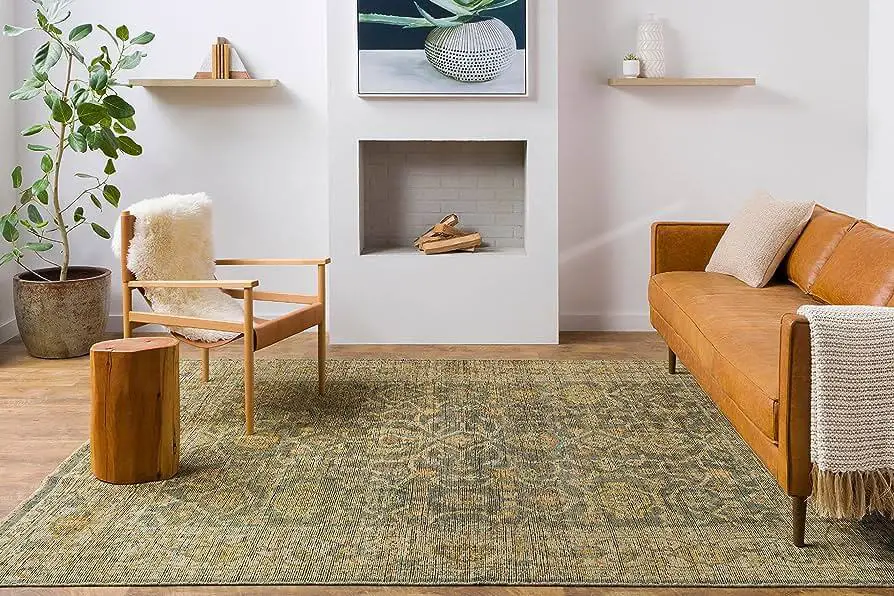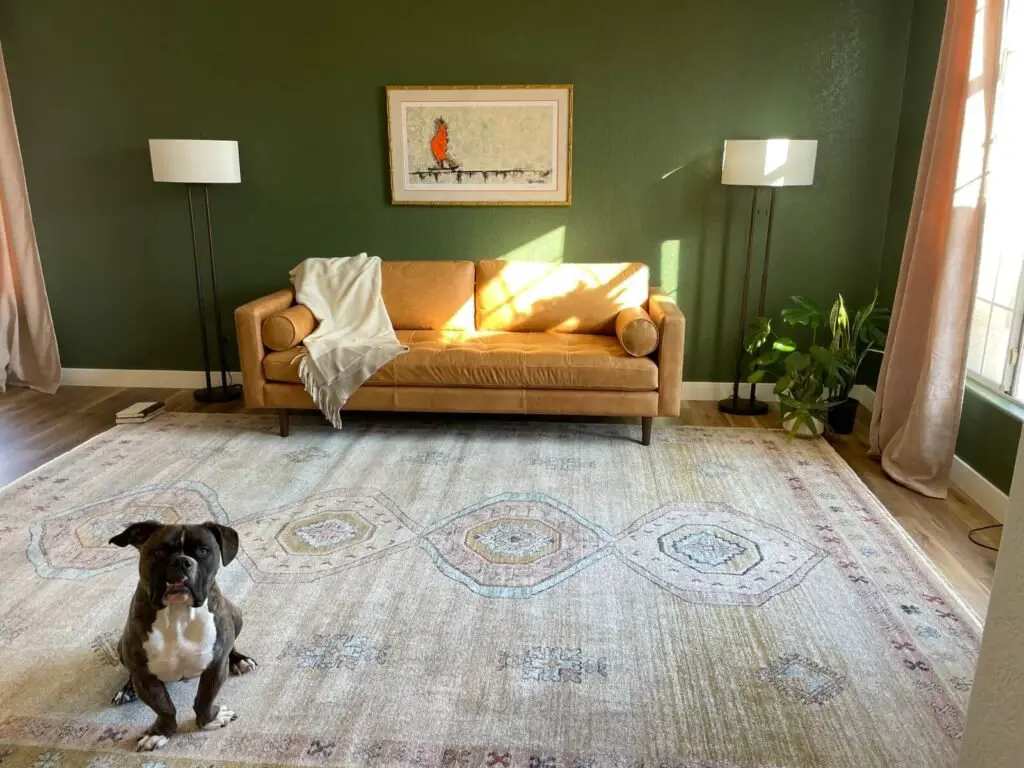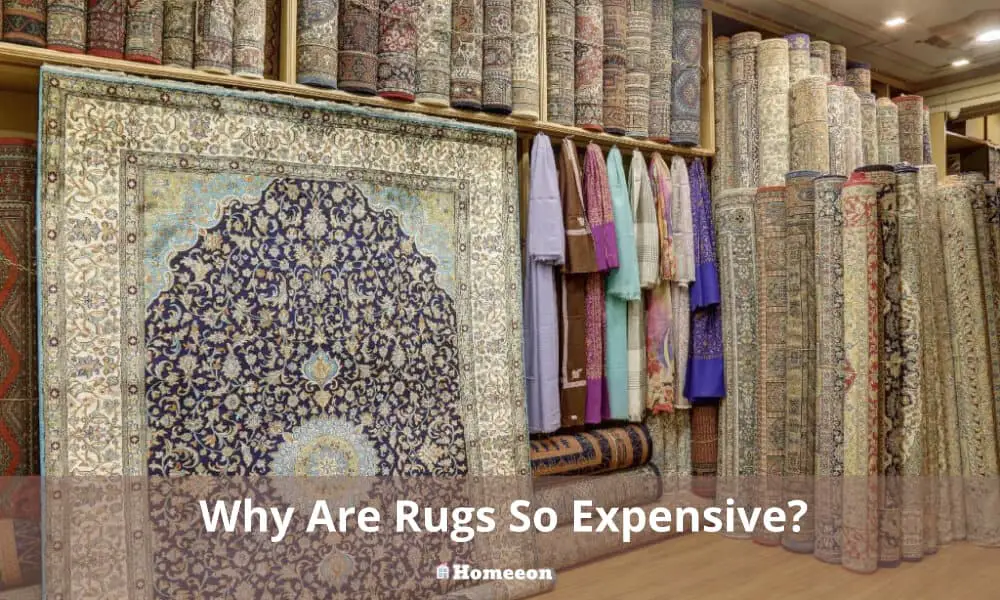Last Updated on August 15, 2023 By Emma W. Thomas
Rugs can be expensive due to factors like material quality, craftsmanship, design complexity, and production methods. Handmade rugs involve intricate weaving, taking months to create. Rare materials, traditional techniques, and intricate designs contribute to higher costs, with prices ranging from hundreds to thousands of dollars.
What makes a rug so expensive?

A lot of factors come to play in determining the price of a rug. The most common factors are the material of a rug, dyes used, origin, and techniques used to make a rug. Since a carpet is a one-time investment, it is advisable to save up and get a quality piece as opposed to buying a cheap one that will last only for a short time. Let’s have an in-depth look at how each of these factors influences the price of rugs.
- Material
The best quality rugs are made from natural animal or plant fibers such as wool, silk, cotton, and sisal. These materials make long-lasting rugs that are easy to clean and air. Rugs made of natural fibers are better for people with allergies compared to their synthetic counterparts. Rugs made of natural material are appealing and do not fade quickly. They are also unique since every material absorbs dye differently, thus making every creation with its pattern. Rugs made of natural fibers have a unique aura that’s worth paying for.
2. Type of dyes used
High-quality rugs are made with natural dyes since they are aesthetically appealing and do not fade off quickly. Natural dyes are extracted from plants and are quite complex to achieve. The skill that goes into extracting and using these dyes on rugs contributes to their high price. A carpet made with natural dyes is environmentally friendly, thus assuring you that when you buy it, you are championing a good cause.
3. Artistry and technique of making rugs
The price of rugs is significantly impacted by the technique and artistry involved to make them. Handwoven rugs are pricier compared to machine-made ones. Knot density is a good measure of the level of skill and precision in a rug. These rugs have better and outstanding details. The more knots a rug has made its art details pop better, thus making the rug pricier. Knotwork is a craft that is only mastered by a few, making every creation unique. Rug weavers in Persia say that hand knitting a “9 x 12” carpet can take up to 1500 hours involving lots of artistry and attention to detail. Unique and fine details together with the time and level of skill required to make one rug make rugs quite expensive.
Now that you understand what goes into making an oriental rug, you will appreciate every work of art and the price that they go for. If you need an authentic rug that will last for years without losing color or texture, it is advisable to save up and get a genuine rug made from natural materials.
What to look for in a rug
Whether you want a rug for your living room or outdoor space, choosing the best rug can be a bit puzzling. You have to balance some aspects of color with size and the aesthetic of your space while still looking at your budget. We came up with a few pointers for a good quality rug that will make work easier for you and save you some bucks in the long run.
- Design
Rugs are available in many designs and patterns, ranging from flowers all the way to geometric. Since there isn’t a one size fits all design for carpets, choosing one that looks appealing in your space is key. When selecting a pattern, consider the rest of the patterns on your furniture and art pieces. If your furniture has flower patterns, choose a plain rug or one with similar flower patterns. The secret is to tone down on patterns so that your space doesn’t look too busy. Choose similar patterns for a calming look.
2. Color
Having a color theme for your home or office space helps to set the right mood and also makes it easy to design these spaces. Choose contrasting colors for your rugs to give your space a luxury feels. If your walls are brightly colored, go for a dull rug. If your furniture has dull colors such as brown or grey, choose a bright rug to liven up the space. Pinterest is an excellent place to look for color inspirations that much the rest of your furniture.
3. Texture
When choosing a rug, be keen on its texture and how it impacts your space. If you want a luxury feel in your home, choose a textured rug. If you want a relaxing feel, the fur-like texture is what you should look for. Textured carpets are known to last longer and are preferred to other types.
4. Price

For rugs, what you pay for is what you get. A cheap rug is most likely made of synthetic materials and can only last a few years. You should save up before buying an oriental rug to get the best quality, but this doesn’t mean you can’t get deals. When buying a rug, compare prices from different sellers, and you might make a huge save. It is economical to buy an expensive rug that will last a lifetime as compared to buying a cheap rug now and then.
Tips to consider when shopping for a rug
Decorating or redecorating a space often involves the careful selection of various elements. One such prime element is a rug. The right rug can bring warmth and depth to your room while uniformly tying the elements of your decor together. Here are ten tips to guide you when shopping for the perfect rug.
1. Size and Scaling
First, consider the size and scaling. The dimensions of the rug need to align with those of the room and its furniture layout. A small rug might get lost in a large room, while an overly large rug might make the room feel cramped.
2. Traffic Considerations
A rug’s durability necessary corresponds to the level of footfall it will receive. High-traffic areas require sturdier materials like wool, which can withstand heavy use.
3. Material Quality
The material also determines the comfort, maintenance, and lifespan of the rug. Natural materials like wool are generally more durable than synthetic materials. However, they also tend to be more expensive.
4. Color Scheme
The color of your rug should harmonize with the color scheme of your room. A monochromatic color scheme highlights texture and form, while a multicolored scheme adds vibrancy and vitality.
5. Texture Aspect
Every rug has a different texture — from soft and plush to rough and hardy. This doesn’t just influence how the rug feels underfoot but can also add a layer of visual interest.
6. Budget Planning
Good quality rugs can be an investment. Plan and allot a budget ahead of time to ensure you select a quality piece that doesn’t break the bank.
7. Pattern Preference
Take into account patterns and styles too. Patterns can add visual intrigue to your space, while plain rugs can often help other aspects of a room stand out more.
8. Maintenance Factor
Choose a rug that suits your willingness and capability to perform maintenance tasks. Some rugs may require professional cleaning while others can be spot-cleaned or vacuumed.
9. Seasonal Change
Consider changing rugs with seasons. Lighter materials for warmer months and heavier rugs for colder seasons not only refresh your space in line with the seasons but also prolong the life of your rugs.
Use these tips as your guide when shopping for a rug, ensuring it harmonizes with your space both aesthetically and practically. Happy rug shopping!
Conclusion
Knowing what is involved in the making of a quality rug helps you appreciate its pricing. When buying a good quality rug, you are paying for the art and skill of a weaver. Choosing the right rug for your space is key to enjoying quality, a life- long service from your carpet. We hope that this guide helps you to understand the price point of rugs and choose a quality rug for your space.
References:
https://www.today.com/tmrw/why-are-rugs-so-expensive-detailed-guide-buying-rug-t203385
https://www.mydomaine.com/why-are-rugs-expensive-4796875
Emma is a graduate of Domestic Science or Family and Consumer Sciences (Home Economics) from the University of Wisconsin. She has 7 years of experience Working with the strategic section of BestBuy and now writing full-time for Homeeon.
From Managing the Home, Interiors, Cleaning, and Exteriors to Gardening and everything about Making A Home Liveable – is her passion and this Homeeon is the result of this.
Emma loves decorating her home with the best stuff found online. She cares about quality over anything and writes reviews about them here in Homeeon. Get in touch with her over Pinterest.
Keep reading her blogs.

